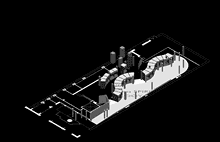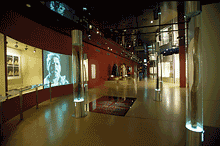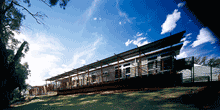Evaluating success
 |
The success of a built environment is evaluated in relation to the criteria established in the design brief. The short and long term consequences of that design need to be considered during the planning of the project. How the environment functions over time is an important way of evaluating success.
For Alison, the best part of the work she does is the positive effect that built environments have on the communities that use them. A year after completion of a project in Maralinga, Alison and Archie Barton, an elder from the local community, were invited to speak at the Melbourne Festival. Alison spoke about the design process and Archie spoke about how the people treated it like it was a really precious place. The sense of ownership that the community felt meant that the building looked as beautiful today as the day it was built.
"For me it's just completely satisfying when a community turns around and pats you on the back and says good job . In every project there are problems that at the time feel like the biggest drama. But at the end of the day it all irons out and the community is happy. Then they invite you to the opening and you go out afterwards with them. It's fantastic. It really is so rewarding. For me and my line of work, if the community can look at a building and say I built that then it's been a complete success and we've done our job right."
Another project Alison is very proud of is the Bayagul exhibition for the Powerhouse Museum. She felt that, in some ways, this was a very daring project.
"I had a rule of no dots and no red earth because that's not appropriate to this country, Sydney. There were no dot paintings here. It's not a Sydney tradition. I wanted to take people out of their stereotypical view of Aboriginal people - walking around in their lap-laps and spears. This is a snaking, beautiful exhibition. It moves around, it has secrets hidden in it that you have to find. Like Aboriginal culture, it isn't all on display. It's something that you have to interact with. But also, we've used really contemporary materials ? aluminium, stainless steel, plywood, glass and really bright colours."
 |
Design as a career option
Merrima , the practice that Alison works with, has been involved in setting up a network of Aboriginal people working in architecture, design, science and engineering. This network provides support to tertiary Indigenous students and assists them in finding a balance between the demands of study and work and their own cultural value systems.
"In our community if you wanted to be spiritual or you wanted to do a job that was cultural in some way, it meant that you had to do something traditional like dance, tell stories or paint. I hope that through what I've done I've opened a few doors for young people and they can go into website design or interior design. I believe that you can completely embrace western technology and still express your Aboriginality and your spirituality."
 |
Awards achieved for projects:
- International Federation of Architects, Contribution to the Design Environment with an emphasis on social awareness and responsibility
- Randwick City Youth Award: Certificate of Recognition ? Academic Achievement and Recognition for Outstanding Contribution to the Local Community in 1998
- Alumni Achievement Award for Outstanding contributions to Campus Community Cultural Activities that are to the benefit of or bring credit to the University of Technology, Sydney
- Scholarship to research Indigenous Architecture ? University of Technology, Sydney: Arizona and Hawaii, USA; Vancouver and Saskatchewan, Canada.



